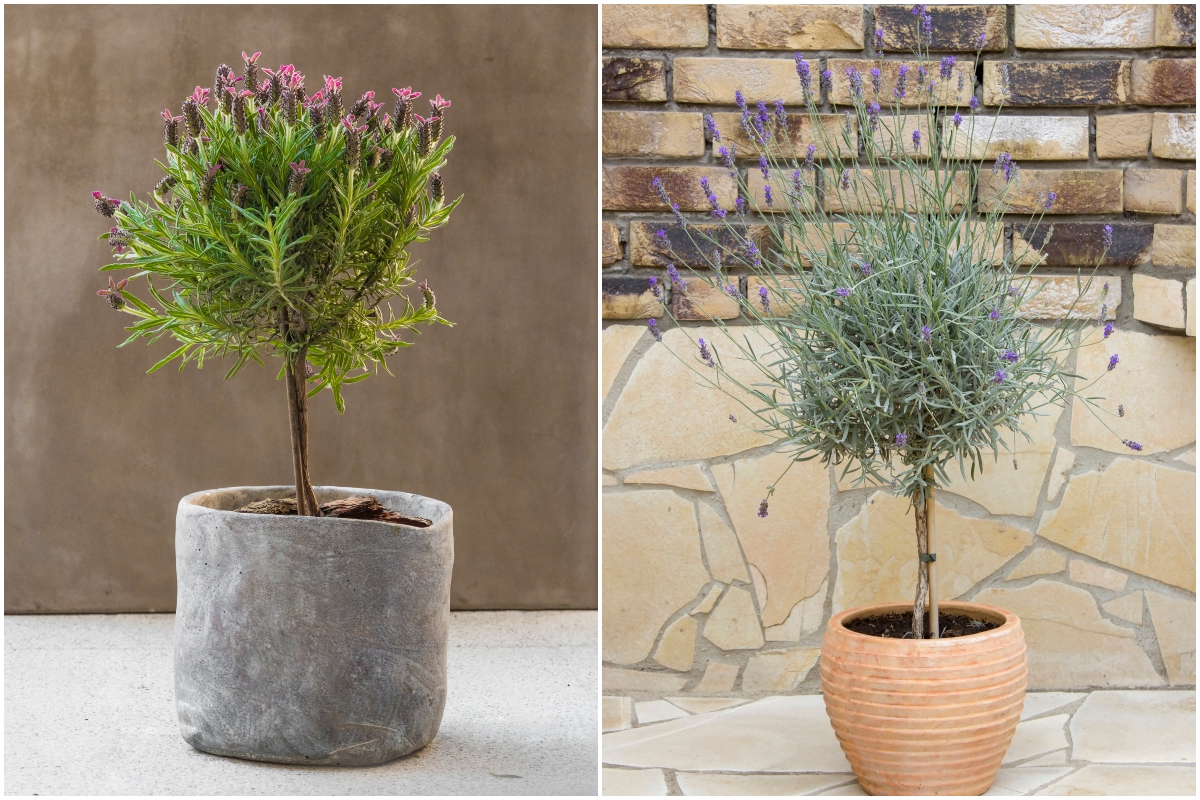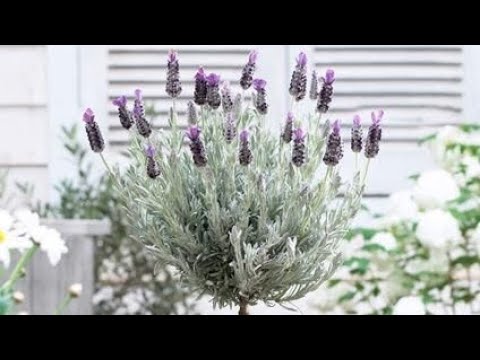To care for lavender topiary, place it in a sunny spot and water it sparingly but consistently, allowing the soil to dry out between watering sessions. Additionally, prune the plant to maintain its shape and encourage bushier growth.
Lavender topiaries are not only beautiful additions to any garden or indoor space but also provide a delightful fragrance. However, keeping these plants thriving requires some knowledge of their specific care requirements. This article will outline essential tips on how to care for lavender topiary, ensuring its long-lasting beauty and health.
Whether you are a seasoned gardener or new to plant care, understanding the proper light, water, and pruning needs of lavender topiaries will ensure their overall well-being. With a little attention and effort, you can enjoy these stunning plants and their soothing aroma for years to come.

Credit: www.bloomingbackyard.com
How to Care for Lavender Topiary: Step by Step Guide
Choosing The Perfect Lavender Topiary For Your Space
Choosing the perfect lavender topiary requires careful consideration of several factors. One crucial aspect is finding the right size for your space, ensuring it complements the surroundings. Additionally, understanding the different lavender varieties for topiary is essential. It enables you to select the one that best suits your preferences and maintenance capabilities.
Each variety has unique characteristics, such as color, scent, and growth habits. By familiarizing yourself with these aspects, you can make an informed decision. Whether you opt for english lavender with its beautiful purple flowers or french lavender with its distinctive fragrance, proper care is crucial.
Regular watering, well-drained soil, and proper pruning are essential factors in maintaining a healthy and vibrant lavender topiary. By following these guidelines, you can enjoy the beauty and aroma of your lavender topiary for years to come.
Providing Optimal Growing Conditions For Your Lavender Topiary
Providing optimal growing conditions for your lavender topiary starts with choosing the right location. A sunny spot with well-draining soil is crucial for its well-being. Lavender topiaries thrive in soil that is slightly alkaline with good drainage. Make sure to select a location that gets at least 6-8 hours of direct sunlight every day.
Watering is essential for the health of your lavender topiary. While lavender is drought-tolerant, it still needs regular watering to establish its roots. Water the topiary deeply but infrequently to encourage deep root growth. Avoid overwatering, as it can lead to root rot.
By providing the proper growing conditions – a suitable location, well-draining soil, and adequate sunlight and watering – you can ensure your lavender topiary remains vibrant and healthy.
Pruning And Shaping Techniques For Lavender Topiary
Pruning plays an important role when caring for lavender topiary. Understanding the tools and techniques used for pruning is essential. By pruning, you not only maintain the topiary’s shape and appearance but also promote healthy growth. It helps in managing the size and density of the plant.
Regularly trimming the lavender topiary prevents it from becoming overgrown and maintains its overall aesthetic appeal. Pruning also helps in removing dead or damaged branches, improving air circulation around the plant. To shape the lavender topiary, use sharp pruning shears and cut back the stems just above a set of healthy leaves or buds.

It is crucial to avoid cutting into woody stems, as this may hinder regrowth. Proper and timely pruning is the key to keeping your lavender topiary flourishing and vibrant.
Preventing Common Issues And Pests For Lavender Topiary
Preventing common issues and pests for lavender topiary is crucial for its health and vitality. Identifying common problems faced by lavender topiary is the first step in maintaining its well-being. Effective disease prevention and management for lavender topiary involves regular inspections and appropriate treatment.
Natural ways to deal with common pests for lavender topiary include using organic insecticides or companion plantings. Regular watering, proper pruning, and adequate sunlight are essential for the overall care of lavender topiary. Remember to avoid overusing chemicals and opt for eco-friendly solutions whenever possible.
By following these guidelines, you can ensure that your lavender topiary thrives and adds beauty to your garden or indoor space.
Harvesting And Using Lavender From Your Topiary
Harvesting lavender from your topiary should be done at the ideal time to ensure its quality. Proper drying and storing techniques are essential to preserve the fragrance and longevity of the lavender. When harvesting, cut the stems just before the flowers bloom fully.
Hang them upside down in a cool, dark place to dry. Once dried, remove the flowers from the stems and store them in an airtight container. Now, let’s explore the creative ways you can use lavender in recipes and crafts.
Add a hint of lavender to your baked goods, such as cookies and cakes, for a unique and fragrant flavor. Infuse lavender into oil or vinegar for homemade dressings and marinades. Create sachets or potpourri with dried lavender flowers to freshen up your home.

With these tips, you can care for your lavender topiary and make the most of its benefits.
Showcasing Your Lavender Topiary Indoors And Outdoors
Show off the versatility of your lavender topiary by placing it indoors or outdoors. For indoor styling, consider placing it on a windowsill or as a centerpiece on a table. To enhance your outdoor space, position the lavender topiary in your garden or on your patio.
Ensure its beauty with regular maintenance and care, such as pruning, watering, and providing adequate sunlight. Avoid overcrowding the plant by giving it enough space to grow. Remember to remove any dead or yellowing leaves to maintain its vibrant appearance.
With these tips, your lavender topiary will be a stunning decorative element in any setting.
Inspiring Lavender Topiary Designs And Projects

Lavender topiaries require tender care and attention to thrive beautifully indoors and outdoors. These inspiring designs and projects will ignite your creativity. Consider unique lavender topiary designs to adorn your living spaces. Embark on exciting diy ideas to bring these projects to life.
Discover the versatility of lavender topiaries in various settings, from cozy corners to grand gardens. Let the aromatic beauty of lavender effortlessly enhance the ambiance of any space. With a little effort and creativity, you can create stunning lavender topiary projects that reflect your personal style.
So, let’s get started on this journey to care for and showcase the captivating charm of lavender topiaries.
Frequently Asked Questions On How To Care For Lavender Topiary
How Often Should I Water My Lavender Topiary?
Water your lavender topiary thoroughly once every two weeks, allowing the soil to dry out between watering. Overwatering can cause root rot and the plant to suffocate, so it’s important to strike the right balance for its health.
Can I Keep My Lavender Topiary Indoors?
Yes, you can keep your lavender topiary indoors, but it needs at least six hours of direct sunlight a day. Place it near a south-facing window or use artificial grow lights if natural light is limited. Additionally, provide good air circulation to prevent mold and mildew.
How Do I Prune My Lavender Topiary?
To prune your lavender topiary, use sharp, clean pruning shears to remove about one-third of the plant’s foliage after it blooms. This will help maintain its shape and prevent leggy growth. Avoid cutting into old wood as lavender has difficulty regrowing from woody stems.
Why Are The Leaves Of My Lavender Topiary Turning Yellow?
Yellow leaves on your lavender topiary can be a sign of overwatering or poor drainage. Ensure the soil is well-draining and reduce the watering frequency. If the yellowing persists, it may indicate a nutrient deficiency. Consider adding a balanced organic fertilizer specifically formulated for lavender.
Can I Use Lavender Topiary In Cooking?
Yes, lavender topiary can be used in cooking but use it sparingly. The flowers lend a delicate, floral flavor to dishes, and both fresh and dried flowers can be used. Ensure you are using culinary lavender, free from pesticides or chemicals.

Lavender pairs well with sweet and savory dishes alike.
Conclusion
Taking care of lavender topiaries can be a fulfilling and rewarding experience. With proper care, these beautiful plants can thrive and bring beauty to any space. Remember to provide adequate sunlight and water regularly, while also allowing the soil to dry out between waterings.
Pruning is essential to maintain the desired shape and encourage new growth. Use a well-draining soil mix and consider supplementing with fertilizer to promote healthy growth. Additionally, be mindful of pests and diseases that can affect lavender topiaries, and take prompt action if any issues arise.
By following these guidelines, you can ensure the longevity and vitality of your lavender topiaries, allowing them to be a stunning and aromatic addition to your garden or indoor space. Happy gardening!

